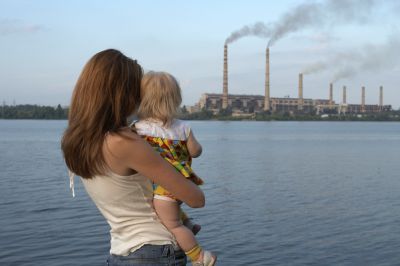Air pollution leads mothers to have smaller babies
A worldwide study has shown that pregnant
mothers exposed to air pollution emitted by vehicles and coal power
plants have smaller babies.
The study, the largest of its kind ever
performed, analysed data from more than three million births in nine
nations at 14 sites in the UK, Europe, North America, South America,
Asia and Australia.
Publishing today in the journal Environmental Health Perspectives, the researchers found the higher the level of pollution, the greater the rate of low birth weight.
Low
birth weight is associated with serious health consequences, including
increased risk of perinatal death, as well as ill health and chronic
health problems in later life.
Professor Tanja Pless-Mulloli,
who led the UK study at Newcastle University, said: “As air pollution
increases we can see that more babies are smaller at birth which in turn
puts them at risk of poor health later in life.
“These
microscopic particles, five times smaller than the width of a human
hair, are part of the air we breathe every day. What we have shown
definitively is that these levels are already having an effect on
pregnant mothers.”
In the UK, Newcastle University researchers
used records from the city going back over 50 years. Allowing for
socio-economic status and occupation, they were able to correlate the
amount of particles in the outdoor air to the birth weight of children.
Low birth weight is defined as less than 2,500 grams or 5lbs 8oz.
Professor
Pless-Mulloli added: “The particles which are affecting pregnant
mothers mainly come from the burning of fossil fuels. In the past the
culprit may have been coal fires, now it is primarily vehicle fumes.
“Currently
in some parts of London we see around 40 units of particulate air
pollution and in Newcastle it is around 20 units but going back to the
1960’s we saw around 700 units of air pollution. While much has been
done to improve air quality, this study shows we can’t be complacent as
we’ve shown that clean air is really important for the health of our
newborns.”
The international study was led by co-principal
investigator Tracey J. Woodruff, PhD, MPH, Professor of Obstetrics and
Gynecology and Reproductive Sciences at the University of California,
San Francisco along with Jennifer Parker, PhD, of the National Center
for Health Statistics, Centers for Disease Control, USA.
In the
study the researchers noted that nations with tighter regulations on
particulate air pollution have lower levels of these air pollutants.
Particulate
matter (PM) found in air pollution is measured in size (microns) and
weight (micrograms per cubic meter). In the European Union, England and
Wales the limit is 25 µg/m3 of particles measuring less than 2.5
microns, and regulatory agencies in Europe are currently debating
whether to lower it.
In the United States and Scotland,
regulations require that there be no more than 12.0 µg/m3 of particles
measuring less than 2.5 microns annually.
The researchers observed that particulate air pollution in Beijing, China recently measured over 700 µg/m3.
“We
would like policy makers to use the results of this study to inform
decisions on whether the permitted levels of air pollution should be
changed,” said Professor Pless-Mulloli. “We would urge countries
considering reviewing their air pollution standards to include estimates
of the growth of newborns as a measure of air quality standards.”
Judith
Rankin, Professor of Maternal and Perinatal Epidemiology at Newcastle
University added: “This should not deter mothers-to-be from taking
exercise outdoors as the benefits of keeping active in pregnancy are
well known. This is not something that individuals can address but that
policy makers need to be considering.”
Reacting to the study
Frank Kelly, Professor of Environmental Health at King’s College London
said: “The study by Dadvand and colleagues removes any doubt that poor
air quality, in the form of particulate pollution, has detrimental
effects on the unborn child. Increasing numbers of studies had suggested
this to be the case but, to date, the evidence had been insufficient to
infer a causal association. This study moves the field forward and
clarifies the work now required to identify the nature and sources of
the particulate pollution responsible to inform policies which remove
these from the air.”
Source: Newcastle University
published: 2013-02-06













































